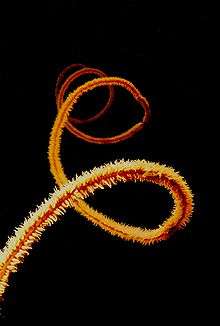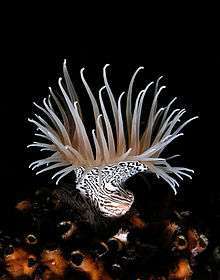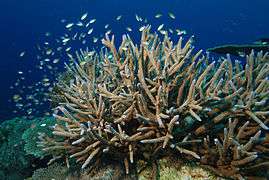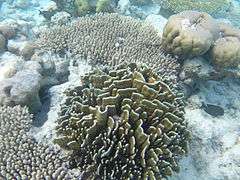Anthozoa
| Anthozoa Temporal range: 570–0 Ma Late Ediacaran to recent | |
|---|---|
.jpg) | |
| Stony corals | |
| Scientific classification | |
| Domain: | Eukaryota |
| Kingdom: | Animalia |
| Subkingdom: | Eumetazoa |
| Phylum: | Cnidaria |
| Class: | Anthozoa Ehrenberg, 1834 |
| Subclasses | |
Anthozoa is a class within the phylum Cnidaria. Unlike other cnidarians, anthozoans do not have a medusa stage in their development. Instead, they release sperm and eggs that form a planula, which attaches to some substrate on which the cnidarian grows. Some anthozoans can also reproduce asexually through budding. More than 6,100 species have been described.[1]
The name comes from the Greek words άνθος (ánthos; "flower") and ζώα (zóa; "animals"), hence ανθόζωα (anthozoa) = "flower animals", a reference to the floral appearance of their perennial polyp stage.
Biology and anatomy
Like those of other cnidarians, the individual polyps have a cylindrical body crowned by a ring of tentacles surrounding the mouth. The mouth leads into a tubular pharynx which descends for some distance into the body before opening into the gastrovascular cavity that fills the interior of the body and tentacles. Unlike other cnidarians, however, the cavity is subdivided by a number of radiating partitions, or mesenteries. The gonads are also located within the cavity walls.[2]
All cnidarian species can feed by catching prey with nematocysts; sea anemones are capable of catching fish and corals of catching plankton. Some of the species also harbour a type of algae, dinoflagellates called zooxanthellae, in a symbiotic relationship; the reef building corals known as hermatypic corals rely on this symbiotic relationship particularly. The zooxanthellae benefit by using nitrogenous waste and carbon dioxide produced by the host while the cnidarian gains photosynthetic capability and increased calcium carbonate production in hermatypic corals.[3]
Anemones and certain species of coral live in isolation; however, most corals form colonies of genetically identical polyps. These closely resemble anemones in structure, although they are generally much smaller. Stony coral are found in most seas.
Phylogeny
| |||||||||||||||||||||||||||||||||||||||
| Phylogeny of Anthozoa[4] |

Anthozoa is subdivided into three subclasses: Octocorallia, Hexacorallia and Ceriantharia, which form monophyletic groups and generally show differentiating reflections on symmetry of polyp structure for each subclass.[4] Historically, a depricated group called Ceriantipatharia was thought to be a separate subclass but, of the two orders it comprised, Antipatharia is now considered part of Hexacorallia and Ceriantharia is now considered an independent subclass. The extant orders are shown to the right.[4][5]
Hexacorallia includes coral reef builders: the stony corals (Scleractinia), sea anemones (Actiniaria), and zoanthids (Zoantharia). Genetic studies of ribosomal DNA has shown Ceriantharia to be a monophyletic group and the oldest, or basal, order among them.[6]
Classification according to the World Register of Marine Species :[7]
- subclass Hexacorallia
- order Actiniaria — sea anemones
- order Antipatharia — black coral
- order Ceriantharia — ceriantharians
- order Corallimorpharia — corralimorphs
- order Rugosa †
- order Scleractinia — stony corals
- order Zoantharia — zoanthids
- subclass Octocorallia
- order Alcyonacea — soft corals and gorgonians
- order Helioporacea — blue corals
- order Pennatulacea — pennatules
Octocorallia comprises the sea pens (Pennatulacea), soft corals (Alcyonacea), and blue coral (Helioporacea). Sea whips and sea fans, known as gorgonians, are part of Alcyonacea and historically were divided into separate orders.[5]
Ceriantharia comprises the related tube-dwelling anemones. Tube-dwelling anemones or cerianthids look very similar to sea anemones, but belong to an entirely different subclass of anthozoans. They are solitary, living buried in soft sediments. Tube anemones live and can withdraw into tubes, which are made of a fibrous material, which is made from secreted mucus and threads of nematocyst-like organelles, known as ptychocysts.
-

Cirrhipathes sp., an Antipatharia
Paleontology
A number of extinct orders of corals have been classified as their calcium skeleton forms a prolific fossil record. These are generally thought to be close to the ancestors of modern Scleractinians and existed during the Paleozoic era 570–245 million years ago:[8][9]
- Numidiaphyllida †
- Kilbuchophyllida †
- Heterocorallia †
- Rugosa †
- Heliolitida †
- Tabulata †
- Cothoniida †
- Tabuloconida †
These are all corals and correspond to the fossil record time line shown below; they comprise the majority of the fossils of Anthozoa due to their calcareous skeleton being preserved.
 | |
|
Timeline of the major coral fossil record and developments from 650 m.y.a. to present.[10][11] |
|
References
- ↑ Crowther, A. L. (2011). "Class Anthozoa Ehrenberg, 1834" (PDF). In Z.-Q. Zhang. Animal biodiversity: an outline of higher-level classification and survey of taxonomic richness. Zootaxa. 3148. pp. 19–23.
- ↑ Barnes, Robert D. (1982). Invertebrate Zoology. Philadelphia, PA: Holt-Saunders International. p. 150. ISBN 0-03-056747-5.
- ↑ Contribution to the BUFUS Newsletter, Field excursion to Milne Bay Province - Papua New Guinea, Madl and Yip 2000
- 1 2 3 Stampar, S.N.; Maronna, M.M.; Kitahara, M.V.; Reimer, J.D.; Morandini, A.C. (March 2014). "Fast-Evolving Mitochondrial DNA in Ceriantharia: A Reflection of Hexacorallia Paraphyly?". PLoS ONE. 9 (1): e86612. doi:10.1371/journal.pone.0086612. PMC 3903554
 . PMID 24475157.
. PMID 24475157. - 1 2 Daly, M.; Brugler, M.P.; Cartwright, P.; Collins, A.G.; Dawson, M.N.; Fautin, D.G.; France, S.C.; McFadden, C.S.; Opresko, D.M.; Rogriguez, E.; Romano, S.L.; Stake, J.L. (2007). "The phylum Cnidaria: A review of phylogenetic patterns and diversity 300 years after Linnaeus" (PDF). Zootaxa. 1668: 1–766. ISSN 1175-5326.
- ↑ Chen, C. A.; D. M. Odorico; M. ten Lohuis; J. E. N. Veron; D. J. Miller (June 1995). "Systematic relationships within the Anthozoa (Cnidaria: Anthozoa) using the 5'-end of the 28S rDNA" (PDF). Molecular Phylogenetics and Evolution. 4 (2): 175–183. doi:10.1006/mpev.1995.1017. PMID 7663762.
- ↑ Hoeksema, Bert (2015). "Anthozoa". World Register of Marine Species. Retrieved 2015-04-24.
- ↑ Oliver W. A., Jr. (1996). "Origins and relationships of Paleozoic coral groups and the origin of the Scleractinia". In G. D. J. Stanley. Paleobiology and Biology of Corals. Columbus, Ohio: The Paleontological Society. pp. 107–134.
- ↑ Ben Kotrc (2005). "Anthozoa: Subgroups". Fossil Groups. University of Bristol. Retrieved 2009-03-23.
- ↑ Ben M. Waggoner (2000). David Smith and Allen Collins, ed. "Anthozoa: Fossil Record". Anthozoa. UCMP. Retrieved 2009-03-23.
- ↑ William A. Oliver, Jr. (2003). "Corals: Table 1". Fossil Groups. USGS. Retrieved 2009-03-23.
External links
| Wikimedia Commons has media related to Anthozoa. |
 Data related to Anthozoa at Wikispecies
Data related to Anthozoa at Wikispecies- "Anthozoa Ehrenberg, 1834". Integrated Taxonomic Information System.




_5.jpg)

